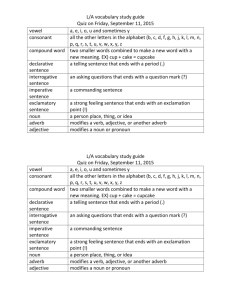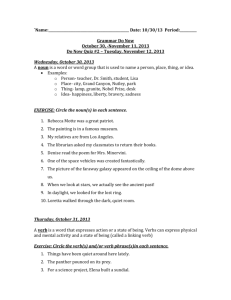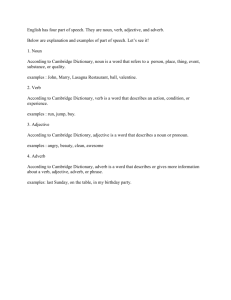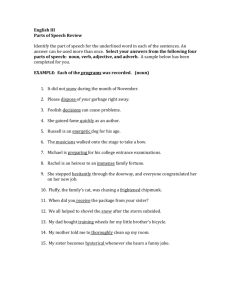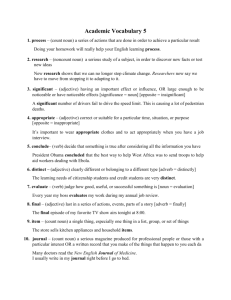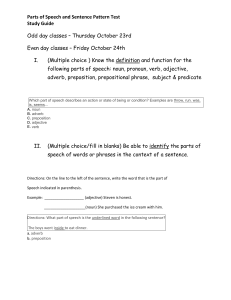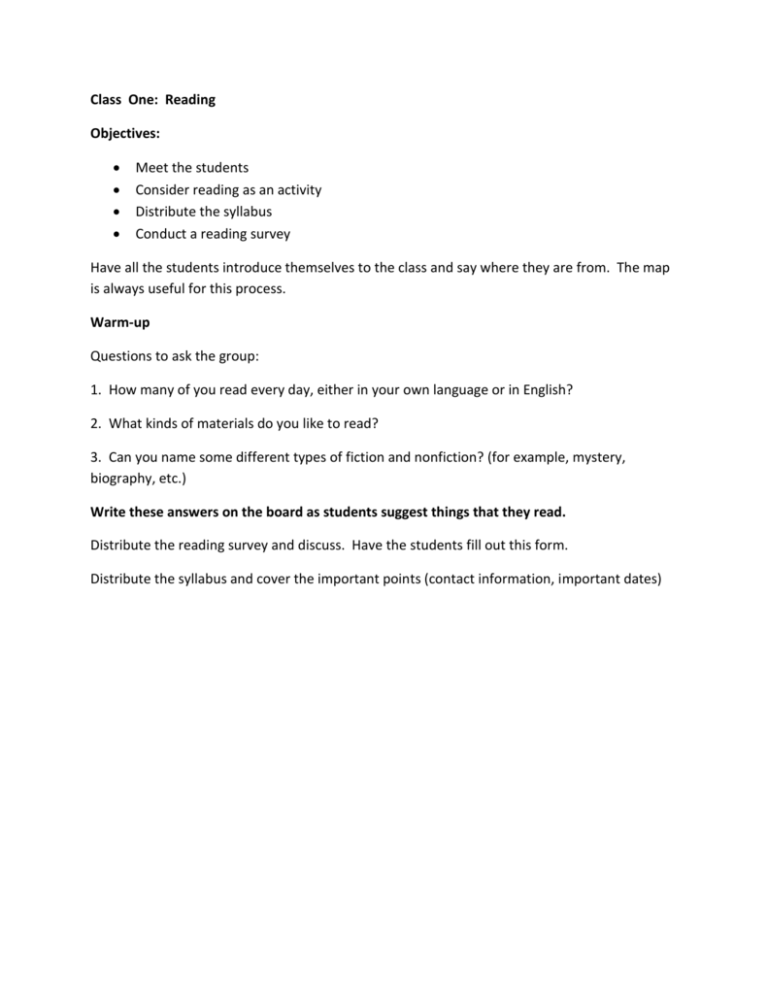
Class One: Reading
Objectives:
Meet the students
Consider reading as an activity
Distribute the syllabus
Conduct a reading survey
Have all the students introduce themselves to the class and say where they are from. The map
is always useful for this process.
Warm-up
Questions to ask the group:
1. How many of you read every day, either in your own language or in English?
2. What kinds of materials do you like to read?
3. Can you name some different types of fiction and nonfiction? (for example, mystery,
biography, etc.)
Write these answers on the board as students suggest things that they read.
Distribute the reading survey and discuss. Have the students fill out this form.
Distribute the syllabus and cover the important points (contact information, important dates)
Reading Survey
Name
Do you read at home?
How do you choose what you want to read?
Who is your favorite author?
What do you read most often? (Check as many as apply)
Newspapers
Internet
Popular magazines
News magazines
Fiction
Nonfiction
Science
Biography
What do you think is the most difficult part about reading in English?
Class Two: Vocabulary Building
Objectives:
Introduce the idea of grouping vocabulary in various ways
Assess what students know about synonyms and antonyms
Introduce the vocabulary notebook as a language learning tool
Warm Up
Put a list of words on the board:
happy
easy
begin
give
top
tall
dark
add
outside
heavy
move
hot
Ask the students to write down the list and add one antonym and one synonym for each word.
When students complete this activity, ask them to share their list with another student.
Put their generated list on the board.
Distribute
Unit One, Lesson One pp.21-28 Reading Basics, Introductory.
Pronounce all the words in the word bank box.
Model some exercises in class. Have students work in pairs.
Homework: The bogglesworld website worksheet, and the remaining exercises in Reading
Basics.
Materials
Unit One, Lesson One pp.21-24 “Recognizing Synonyms,” Reading Basics, Introductory
www.bogglesworldesl.com (This website has many activities to practice synonyms)
Use the words in the box to find synonyms for the italicized words:
chair
sick
throw
like
easy
little
big
late
angry
rock
thin
jump
Jack was mad because the other kids teased him.
(1)
It was a simple question.
(2)
The pumpkin was so huge that I couldn’t carry it.
(3)
The teacher was angry because the students were tardy.
(4)
Toss me the ball!
(5)
I enjoy drinking tea in the morning.
(6)
Sally wasn’t at school because she was ill.
(7)
Someone was sitting in my seat.
(8)
Someone threw a stone and broke the window.
(9)
He tried to hop over the puddle.
(10)
The baby’s hands were tiny.
(11)
He is so skinny that his clothes don’t fit anymore.
(12)
© 2007 www.bogglesworldesl.com
Class 3: Reading Assessment
Objectives:
administer the reading CASAS
Cultural Tip: In many cultures, it is perfectly acceptable to cheat. In fact, a person may be
expected to give answers to his or her friend who may not know the answers.
Explain that the test results will help the teacher track the student’s progress, and will help
determine the student’s particular weaknesses. In any case, be alert to cheating!
Class 4: Vocabulary Building with Synonyms
Objectives:
Review synonyms from last week
Play a concentration game with synonym cards
practice pronunciation of targeted words
Warm Up
Check to see who has completed the homework. Remind the students to check the box on the
sign-in sheet when they do the homework.
Do an oral review of the words.
Main Activity
Divide students into groups of 4. Distribute the concentration playing cards. Explain the rules
of the game. Be ready to circulate among the groups to monitor their playing techniques.
Reward the winners!
Materials:
Concentration game from http://bogglesworldesl.com
Unit One, Lesson Two pp.25-28 “Recognizing Synonyms,” Reading Basics, Introductory
Homework:
Complete Unit One, Lesson Two pp.25-28 “Recognizing Synonyms,” Reading Basics,
Introductory
Note: If you have students who have a COMPASS score in the 50-65 range, give the
homework from the Reading Basics, Intermediate 1. These students have a more developed
vocabulary and will need more challenging homework.
seat
chair
simple easy
mad
angry
tiny
little
stone
rock
toss
throw
enjoy
like
hop
jump
shut
close
tidy
clean
silent quiet
begin start
chat
talk
weird
strange
clever smart
skinny
thin
loud
noisy
middle center
ill
sick
huge
big
difficult
hard
late
tardy
friendly
kind
naughty
bad
finish
end
Class 5: Reading an Article
Objectives:
Discuss techniques we use when studying another language
Introduce the process of reading and evaluating text
Recognize in text clues for synonyms
Warm Up
Ask students where and when they use spoken English. (Examples: doctor’s office, government offices,
children’s schools)
Distribute the first page of “Learning a Second Language”
Brainstorm a list of things that we can do to help ourselves learn a new language (Examples: watch tv
with closed captioning, listen to the radio, read in English, talk to people in stores or on the street to
practice asking questions, write down new words, etc.)
Main Activity
Give the students time to read the article silently and then read aloud to them. Ask for volunteers to
read each paragraph.
Put new vocabulary words on the board: brief, all at once, risks, patient, gradual, in other words,
positive
Find the words in the text and see if there are any clues to meaning of the new words.
Materials
“Learning a Second Language,” from Unit Two of Themes for Today, pp. 32-45
Homework: Complete the exercises on pp. 33-39.
Class 6: Recognizing Parts of Speech in Reading
Objectives
Begin a targeted study of recognizing nouns
Learn the difference between proper and common nouns
Nouns with irregular plurals
Warm Up: Put a list of words on the board that include words that are both a verb and a noun. Some
examples are: present, permit, produce. Write a sentence with the word as a verb and then a noun.
See if the students can identify the differences. Talk about word order. Discuss articles and the way
that nouns are signaled by the presence of an article.
Main Activity:
Distribute copies of “Nouns” to each student. Use a student as an example: A student is a singular,
common noun, but Juana Diaz is a proper noun. Ask students to complete p. 18 in class and then check
as a group.
Divide students into groups and give one person in each group the title of “Notetaker.” Ask each group
to make a list of all the nouns in the reading “Learning a Second Language.” Divide the list into
categories of singular/plural, common and proper.
Bring the class back together and have students put their lists on the board.
Materials: “Learning a Second Language,” from Unit Two of Themes for Today, pp. 32-45
Unit One, Lesson One pp.18-21 “Nouns,” Language Builder, Introductory
Homework: Complete the exercises in “Nouns, pp. 19-21.
Reading Class 7: Word Forms
Objectives
compare the form and function of adjectives and adverbs
work with vocabulary in context
using knowledge about parts of speech to select answers in reading quizzes
Warm Up: Put the following two sentences on the board and ask students to identify and explain the
error in each one.
The man is very quietly.
The boy walked slow.
Main Activity: Distribute copies of “Adjectives or Adverb?” to the students. Compare how the two
words are used in sentences, and their placement in the word order. Ask students to complete the
exercise on p. 58 and then check as a group.
Turn to page 40 of “Learning a Second Language.” These kinds of exercises are very difficult for this
level student. Do them together slowly, taking time to explain each one and compare the structure of
the two sentences (one which needs an adjective, and the other one needing an adverb).
Ask the students to do the first set of vocabulary exercises on p. 41 “Learning a Second Language.” Ask
them to explain how their knowledge about parts of speech can help select an answer.
Homework: Complete the vocabulary exercises on pp. 41-42.
Materials: “Learning a Second Language,” from Unit Two of Themes for Today, pp. 32-45
Unit One, Lesson 11, pp.58-61 “Adjective or Adverb?” Language Builder, Introductory
Online Resources: http://www.funbrain.com/cgibin/gg.cgi?A1=m&A2=0&A3=0&AFUNCT=1&ALEVEL=0 (This is a fun interactive game with parts of
speech if you have computers available).
http://owl.english.purdue.edu/handouts/index2.html#parts This is the OWL Writing Center website at
Purdue with many handouts available for students who need more practice with this skill.
Adjective or Adverb? (For teacher reference)
Brought to you by the Purdue University Online Writing Lab.
Graphics for this handout were designed by Michelle Hansard.
Basic Rules
1. Adjectives modify nouns; adverbs modify verbs, adjectives, and
other adverbs.
You can recognize adverbs easily because many of them are formed by
adding -ly to an adjective.
Here are some sentences that demonstrate some of the differences between
an adjective and an adverb by showing what is being modified in each
sentence. In each sentence, light blue arrows point to adjectives and green
arrows point to adverbs.
Here careless is an adjective that
modifies the proper noun Richard.
Here carelessly is an adverb that
modifies the verb talks.
Here happy is an adjective
that modifies the proper
noun Priya and extremely is
an adverb that modifies the
adjective happy.
Here quickly is an adverb
that modifies the verb
finished and unusually is an
adverb that modifies the
adverb quickly.
Adverbs can't modify nouns, as you can see from the following incorrect
sentences.
He is a quietly man.
The correct sentence should say He is a quiet
man.
I have a happily dog.
The correct sentence should say I have a
happy dog.
On the other hand, it's sometimes easy to make the mistake of using an
adjective to modify a verb, as the incorrect sentences below show.
He talks careless about
your wife.
The correct sentence should say He talks
carelessly about your wife.
He is breathing normal
again.
The correct sentence should say He is breathing
normally again.
2. An adjective always follows a form of the verb to be when it
modifies the noun before the verb.
Here are some examples that show this rule. Light blue arrows point from
the adjective to the noun that it modifies.
3. Likewise, an adjective always follows a sense verb or a verb of
appearance -- feel, taste, smell, sound, look, appear, and seem -when it modifies the noun before the verb.
Here are some examples that show this rule. Light blue arrows point from
the adjective to the noun it modifies.
Here bad is an adjective that modifies the
noun cough. Using the adverb badly here
would not make sense, because it would
mean her cough isn't very good at sounding.
Here awful is an adjective that modifies the
noun oil. Using the adverb awfully here would
not make sense, because it would mean that
castor oil isn't very good at tasting.
Here fresh is an adjective that modifies the
noun air. Using the adverb freshly here would
not make sense, because it would mean that
the air has a sense of smell that it uses in a
fresh manner.
Here unhappy is an adjective that modifies
the pronoun she. Using the adverb unhappily
here would not make sense, because it would
mean that she isn't very good at seeming.
Here dark is an adjective
that modifies the noun
images. Using the adverb
darkly here would not make
sense, because it would
mean that the images were
suddenly popping into view
in a dark manner.
Be careful to notice whether the word modifies the subject or the verb in the
sentence. If the word modifies the subject, you should use an adjective. If
the word modifies the verb, you should use an adverb. The difference is
shown in the following pair of sentences.
Here sweet is an adjective that modifies the
noun apple. Using the adverb sweetly here
would not make sense, because it would
mean that the apple can smell things in a
sweet manner.
Here carefully is an adverb that modifies the
verb smells. Using the adjective careful here
would not make sense, because it would
mean that the dog gives off an odor of
carefulness.
Avoiding Common Errors
Bad or Badly?
When you want to describe how you feel, you should use an adjective (Why?
Feel is a sense verb;see rule #3 above). So you'd say, "I feel bad." Saying
you feel badly would be like saying you play football badly. It would mean
that you are unable to feel, as though your hands were partially numb.
Good or Well?
Good is an adjective, so you do not do good or live good, but you do well
and live well. Remember, though, that an adjective follows sense-verbs and
be-verbs, so you also feel good, look good, smell good, are good, have been
good, etc. (Refer to rule #3 above for more information about sense verbs
and verbs of appearance.)
Confusion can occur because well can function either as an adverb or an
adjective. When well is used as an adjective, it means "not sick" or "in good
health." For this specific sense of well, it's OK to say you feel well or are well
-- for example, after recovering from an illness. When not used in this
health-related sense, however, well functions as an adverb; for example, "I
did well on my exam."
Double-negatives
Scarcely and hardly are already negative adverbs. To add another negative
term is redundant, because in English only one negative is ever used at a
time
They found scarcely any animals on the island. (not scarcely no...)
Hardly anyone came to the party. (not hardly no one...)
Sure or Surely?
Sure is an adjective, and surely is an adverb. Sure is also used in the
idiomatic expression sure to be. Surely can be used as a sentence-adverb.
Here are some examples that show different uses of sure and surely. Light
blue arrows indicate adjectives and green arrows indicate adverbs.
Here sure is an adjective
that modifies the
pronoun I.
Here surely is an adverb
that modifies the
adjective ready.
Here sure to be is an
idiomatic phrase that
functions as an adjective
that modifies the
pronoun she.
Here surely is an
adverb that modifies
the verb has been.
Real or Really?
Real is an adjective, and really is an adverb. Here are some examples that
demonstrate the difference between real and really. Light blue arrows
indicate adjectives and green arrows indicate adverbs.
Here really is an adverb that
modifies the adverb well.
Here really is an adverb that
modifies the verb phrase going out.
Here real is an
adjective that
modifies the noun
problems.
Near or Nearly?
Near can function as a verb, adverb, adjective, or preposition. Nearly is used
as an adverb to mean "in a close manner" or "almost but not quite." Here
are some examples that demonstrate the differences between various uses
of near and nearly. Light blue arrows indicate adjectives and green arrows
indicate adverbs. Subjects and verbs are marked in purple.
Here neared is a verb in the
past tense.
Here nearly is an adverb
that modifies the verb
finished.
Here near is an adjective
that modifies the noun
future.
Here near is an adverb of
place that modifies the verb
crept.
Here nearly is an
adverb that
modifies the verb
related.
Here near is a
preposition.
The
prepositional
phase near the
end of the
movie modifies
the noun
scene.
After reviewing this handout, try the following interactive exercises and
check your answers online.
Adjective/Adverb Exercise #1
Adjective/Adverb Exercise #2
This handout revised December 2001 by Michelle Hansard
Get a printer-friendly
version of this page.
Get an Adobe PDF
version of this page.
owl home || writing lab and owl || handouts || workshops and presentations || internet resources
This page is located at http://owl.english.purdue.edu/handouts/esl/esladjadv.html
Receive weekly tips and updates from Purdue's OWL and Writing Lab!
your email
Join
Copyright ©1995-2004 by OWL at Purdue University and Purdue University. All rights reserved.
Use of this site constitutes acceptance of our terms and conditions of fair use.
To contact OWL, please refer to our contact information page so that you email the appropriate person. Requests
for help sent to the wrong address may not receive a timely response.
Reading Class 8: How do we learn a second (or third or fourth) language?
Objectives
give advice to a friend
try to use vocabulary from the chapter in an original context
Warm Up: Ask if students know the format of a friendly, casual letter in English. If not, use the
supplemental materials to teach them the basics (very briefly).
Main Activity: Tell the students to imagine that a family member or friend is planning to move to the
United States very soon. Write a letter to him/her to explain what to expect and to give advice about
how to learn English as quickly as possible.
When the students have finished, ask them to share their letters by reading aloud. Sometimes students
are more willing to do this if they are in smaller groups.
Homework: Model the crossword puzzle on p. 47 of “Learning a Second Language.” Tell students to
complete this as a way to study for the quiz to be given in the next class.
Friendly or Personal Letters
Personal letters, also known as friendly letters, and social notes normally
have five parts.
1. The Heading. This includes the address, line by line, with the last line
being the date. Skip a line after the heading. The heading is indented to the
middle of the page. If using preaddressed stationery, add just the date.
2. The Greeting. The greeting always ends with a comma. The greeting
may be formal, beginning with the word "dear" and using the person's given
name or relationship, or it may be informal if appropriate.
Formal: Dear Uncle Jim, Dear Mr. Wilkins,
Informal: Hi Joe, Greetings,
(Occasionally very personal greetings may end with an exclamation point for
emphasis.)
3. The body. Also known as the main text. This includes the message you
want to write. Normally in a friendly letter, the beginning of paragraphs is
indented. If not indented, be sure to skip a space between paragraphs. Skip
a line after the greeting and before the close.
4. The complimentary close. This short expression is always a few words
on a single line. It ends in a comma. It should be indented to the same
column as the heading. Skip one to three spaces (two is usual) for the
signature line.
5. The signature line. Type or print your name. The handwritten signature
goes above this line and below the close. The signature line and the
handwritten signature are indented to the same column as the close. The
signature should be written in blue or black ink. If the letter is quite
informal, you may omit the signature line as long as you sign the letter.
Postscript. If your letter contains a postscript, begin it with P.S. and end it
with your initials. Skip a line after the signature line to begin the postscript.
See also Layout of a friendly letter.
See also Commas in Letters and Capitalization in Letters
Complete Contents
Glossary
Grammar Contents
Everyone deserves a great education. Now anyone can earn online degrees from home, whether you
have a full time job or children to watch, earning an online degree from an accredited online university
can become a reality.
(Notice Posted 30 June 2008)
Copyright©1997-2008 English Plus, All rights reserved.
Reading Class 9: Vocabulary Quiz
Objectives
take a vocabulary quiz
Main Activity:
Distribute the quiz. You may need to separate students so they can’t see each other’s papers.
Homework: Write a paragraph about homework and tests in your own country.
Choose one of the following words for each sentence to fill in the blank.
trouble
accomplishments
perhaps
risks
journal
patient
1. When you are taking care of very young children, you should always be very
with them.
2. Gilberto is very tired today.
3. Many people have
he didn’t sleep well last night.
with irregular verbs in English.
4. Your daughter won 2 awards for her excellent grades. You must be very
proud of her
!
5. My teacher says that I should write in a
every day.
6. I don’t enjoy gambling, or betting money, because I don’t like to take
___________________.
Write a sentence for each of the following words.
gradual
achievement
improve
positive
Circle the correct definition for the word that is underlined in each
sentence.
1. I know several people in that class.
a. easier
b. many
c. different
2. You should keep a record of the money you spend.
a. write it on paper
b. remember it
c. tell someone
3. We learn a new language gradually, not all at once.
a. quickly
b. carefully
c. slowly
4. After several weeks of class, many students felt their English was
improving.
a. after a few days
b. when a few weeks are finished
c. a week later
5. The student was so happy to see his own improvement.
a. getting worse
b. getting better
c. remaining the same
Reading Class 10: “Don Francisco’s Six Steps to Better English”
Objectives
read an article on language acquisition
compare ideas from the last article
Warm Up
If you have a large Spanish speaking population in your class, this is a perfect opportunity to let them be
the “expert.” Ask them to explain who Don Francisco is. (He is a well-loved, wildly popular TV host).
Main Activity:
Distribute copies of “Don Francisco’s Six Steps to Better English.”
Divide the students into pairs. Ask each pair to read the article and summarize the 6 steps.
Then, compare those steps with the suggestions in the last article.
(I especially love his suggestions for seeking out the specific kind of person with whom to launch a
conversation,)
Materials
“Don Francisco’s Six Steps to Better English,” from How I Learned English: 55 Accomplished Latinos
Recall Lessons in Language and Life, Tom Miller, ed. National Geographic: Washington, D.C. 2007.
Homework: Read and summarize Josefina Lopez’s article, “Really.”
Note:
If students respond well to this essay, a second one that may be used for an out of class reading is from
the same book, by Josefina Lopez, called “Really.” It’s short and very funny, and students who have read
it really enjoy the story.
Reading Class 11: “Food and Culture”
Objectives
define culture
discuss the parameters and influences of culture
list foods that are important in each student’s home culture
Warm Up
Divide the students into groups. Ask them to create a list of all components of culture that they can
think of. (Help them to begin, if they need it: music, food, traditions, family structure) Then, ask them
to rank their list in the order of most important to the least important. If you have groups that produce
very different lists, put several on the board. If the lists are fairly similar, put one list on the board.
Main Activity
Ask the students what they miss most about their country (excluding family and friends). Most of them
will probably say “Food!”
Divide the students into groups that reflect their countries (a group of Cubans, a group of Turkish
Russians or any other group). Ask each group to make a short list of traditional foods or dishes from
their home country.
Compare notes on the different kinds of food. How many people like Chinese food? Mexican? Korean?
Distribute p. 49 of “Food and Culture” to the students. Ask them to interview 4 classmates and fill in the
chart.
Material:
Reading Class 12: “Food and Culture”
Objectives
Make predictions about an article
Read an article about food and culture
Warm Up
Ask students to examine the picture on page 49 of “Food and Culture.” Ask them to write down
3 ideas that they think might be part of the article they are preparing to read. Compare these
predictions with another student.
Main Activity
Distribute “Food and Culture.” Ask the students to turn to page 54 and read the article silently.
While they are reading, put the following words and definitions on the board: raw, taste, meat
and few.
How did the predictions compare with the real article?
Read together as a group and discuss.
Material: “Food and Culture,” from Unit Two of Themes for Today, pp. 49-66.
Online Resources:
http://www.pbs.org/opb/meaningoffood/food_and_culture/gonna_eat_that/
This website is really fun if you have a mixed class and computer access. This is a list of
completely bizarre foods that are eaten in different cultures.



